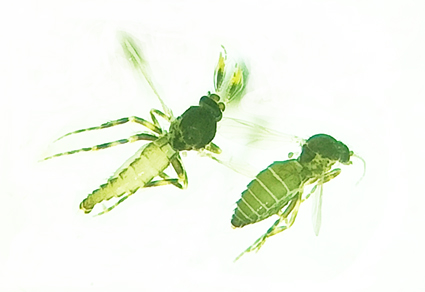Abstract
Three new species of the subgenus Lepidohelea Kieffer, 1917 of the genus Forcipomyia were described from the northern region of West Bengal based on morphological data. Forcipomyia (L.) inflatistyla sp. n. was collected from the Dooars region (Jayanti, near the Core area of Buxa Tiger Reserve), while two new species F. (L.) ranula and F. (L.) sulcoa were procured from Kalimpong in the Eastern Himalaya. Discovery of the three new species raises the total number of species of the genus Forcipomyia to 86 in India. A key to the Indian species of Lepidohelea is also provided.
References
- Alwin, A. & Szadziewski, R. (2013) Biting midges of the subgenus Trichohelea of Forcipomyia in Poland, with keys for the determination of Polish subgenera (Diptera: Ceratopogonidae). Polish Journal of Entomology, 82, 113–126. https://doi.org/10.2478/v10200-012-0028-5
- Borkent, A. (2014) The pupae of the biting midges of the world (Diptera: Ceratopogonidae), with a generic key and analysis of the phylogenetic relationships between genera. Zootaxa, 3879 (1), 1–327. https://doi.org/10.11646/zootaxa.3879.1.1
- Borkent, A. & Dominiak, P. (2020) Catalog of the biting midges of the world (Diptera: Ceratopogonidae). Zootaxa, 4787 (1), 1–377. https://doi.org/10.11646/zootaxa.4787.1.1
- Bystrak, P.G. & Wirth, W.W. (1978) The North American species of Forcipomyia, subgenus Euprojoannisia (Diptera: Ceratopogonidae). United States Department of Agriculture, Technical Bulletin, 1591, 1–51.
- Chen, Y.H., Lee, M.F., Lan, J.L., Chen, C.S., Wang, H.L., Hwang, G.Y. & Wu, C.H. (2005) Hypersensitivity to Forcipomyia taiwana (biting midge): Clinical analysis and identification of major for t 1, for t 2 and for t 3 allergens. Allergy, 60 (12), 1518–1523. https://doi.org/10.1111/j. 1398-9995.2005.00918.x.
- Debenham, M.L. (1987) The biting midge genus Forcipomyia (Diptera: Ceratopogonidae) in the Australasian Region (exclusive of New Zealand). III. The subgenera Forcipomyia, s.s. and Lepidohelea. Invertebrate Taxonomy, 1, 269–350. https://doi.org/10.1071/IT9870269
- de Meillon, B. (1931) A new species of Forcipomyia (Diptera, Ceratopogonidae) from the Transvaal, with a description of its early stages. Transaction of the Entomological Society of London, 79, 335–340. https://doi.org/10.1111/j.1365-2311.1931.tb00704.x
- Ingram, A. & Macfie, J.W.S. (1924) Notes on some African Ceratopogoninae—species of the genus Forcipomyia. Annals of Tropical Medicine and Parasitology, 18, 533–593. https://doi.org/10.1080/00034983.1924.11684432
- Kaufmann, T. (1975) Studies on the ecology and biology of a cocoa pollinator, Forcipomyia squamipennis I. & M. (Diptera, Ceratopogonidae), in Ghana. Bulletin of Entomological Research, 65 (2), 263–268. https://doi.org/10.1017/S0007485300005940
- Kieffer, J.J. (1911) Les chironomides de (Tendipedidae) de l’Himalaya et d’Assam. Records of the Indian Museum, 6, 319–349. [Dec.] https://doi.org/10.26515/rzsi/v6/i5/1911/163078
- Kieffer, J.J. (1917) Chironomides d’Amérique conservés au Musée National Hongrois de Budapest. Annales Historico-Naturales Musei Nationalis Hungarici, 15, 292–364.
- Lee, D.J., Reye, E.J. & Dyce, A.L. (1963) Sand flies as possible vectors of disease in domesticated animals in Australia. Proceedings of the Linnean Society of New South Wales, 87, 364–376.
- Liu, J.H., Yan, G. & Liu, G.-P. (1996) The biting midge from Hainan Island. Military Medical Science Press, Beijing, vi + 184 pp. [in Chinese, English summary]
- Ma, H.J., Yan, G., Hong, X., Wu, C. & Liu, F. (2000) A preliminary survey on mosquitoes and midges and a new species of biting midges from south-mountain area, Anhui Province, China. Medical Journal of the Chinese People’s Armed Police Forces, 11, 14–16. [in Chinese]
- Macfie, J.W.S. (1934) Fauna sumatrensis. Bijdrage No. 75, Ceratopogonidae (Diptera). Tijdschrift voor Entomologie, 77, 202–231.
- Pal, G.S. & Hazra, N. (2022) Addition of species to the hematophagous biting midges of the Forcipomyia Meigen (Diptera: Ceratopogonidae) from West Bengal, India. Journal of Entomological and Acarological Research, 54 (2), e10429. https://doi.org/10.4081/jear.2022.10429
- Pal, G.S., Brahma, S. & Hazra, N. (2023) One new species and new records of three species of the genus Forcipomyia Meigen, 1818 (Diptera, Ceratopogonidae) from West Bengal, India. Evolutionary Systematics, 7 (1), 83–89. https://doi.org/10.3897/evolsyst.7.97331
- Pal, G.S., Ghosh, L. & Hazra, N. (2024a) One new and first record of four species of genus Forcipomyia Meigen, 1818 (Diptera: Ceratopogonidae) from India. Oriental Insects, 58 (1), 137–156. https://doi.org/10.1080/00305316.2023.2245824
- Pal, G.S., Chatterjee, S. & Hazra, N. (2024b) Two new species of the subgenus Lepidohelea Kieffer of Forcipomyia Meigen (Diptera: Ceratopogonidae) from West Bengal, India. Biologia, 79, 449–455. https://doi.org/10.1007/s11756-023-01531-2
- Paul, N., Harsha, R. & Mazumdar, A. (2014) A new species of Forcipomyia Meigen (Diptera: Ceratopogonidae) described with immature stages from India. Zootaxa, 3881 (2), 165–174.
- https://doi.org/10.11646/zootaxa.3881.2.5
- Saha, P.K., Das Gupta, S.K., Gangopadhyay, D. & Mukherjee, T.K. (2009) A morphotaxonomic study of the Indian species of Forcipomyia Meigen biting midges (Diptera: Ceratopogonidae). Records of the Zoological Survey of India: Occasional Paper, No. 299, i–iv + 1–92.
- Szadziewski, R. (2016) Biting midges (Diptera: Ceratopogonidae) as indicators of biostratigraphy, ecological reconstructions and identification of amber deposits. Earth Environmental Science Transactions of the Royal Society of Edinburgh, 107 (2–3), 219–230. https://doi.org/10.1017/S1755691017000378
- Tokunaga, M. & Murachi, E.K. (1959) Insects of Micronesia. Diptera: Ceratopogonidae. Insects of Micronesia, 12 (3), 103–434.
- Wirth, W.W. (1956) New species and records of biting midges ectoparasitic on insects (Diptera, Heleidae). Annals of the Entomological Society of America, 49, 356–364. https://doi.org/10.1093/aesa/49.4.356
- Wirth, W.W. (1991) New and little-known species of Forcipomyia (Diptera: Ceratopogonidae) associated with cocoa pollination in Brazil. Proceedings of the Entomological Society of Washington, 93, 163–175.
- Wirth, W.W. & Marston, N. (1968) A method for mounting small insects on microscope slides in Canada balsam. Annals of the Entomological Society of America, 61, 783–784. https://doi.org/10.1093/aesa/61.3.783
- Wirth, W.W. & Navai, S. (1978) Terminology of some antennal sensory organs of Culicoides biting midges (Diptera: Ceratopogonidae). Journal of Medical Entomology, 15, 43–49. https://doi.org/10.1093/jmedent/15.1.43
- Yeh, C.C. & Chuang, Y.Y. (1996) Colonization and bionomics of Forcipomyia taiwana (Diptera: Ceratopogonidae) in the laboratory. Journal of Medical Entomology, 33 (3), 445–448. https://doi.org/10.1093/jmedent/33.3.445


